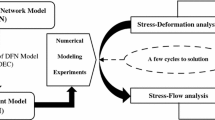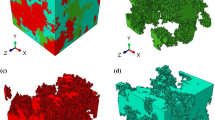Abstract
The effect of geo-stress fields on macroscopic hydro-geological conditions or microcosmic permeability of water-bearing media should follow some laws or principles. Cases study and tests show that: (1) At macro-geologic large scale, deformed and crashed rocks which were induced by geo-stress fields changing provided space for groundwater storage and flow. Groundwater adjusts water-bearing space and dilatants fractures by flowing and press transferring. Coupling of liquid and solid can be implemented for rocks and groundwater. Although tectonic fields witness several times of change and build-up in geological time, stress fields forming regional tectonic framework are coherent with seepage fields, orientation of the maximum horizontal stress demonstrates main seepage directions. (2) At macro-geologic middle scale, zones of stresses changing sharply, quite low stresses, stress or shear concentration can be used to show locations and types of main fractures, zones of geo-stresses changing equably can be acted as normal base media zones of tri-porosity media. (3) At micro-geologic small scale, tri-porosity media include fractured rocks, porous rocks and capillary rocks. Investigations indicate that porosity or permeability is functions of effective stresses, and porosity or permeability changing rules of porous rocks with variation of effective stresses can be described as the index model, the model of power exponent functions is suitable for those of fractured rocks, the model of the second power parabola for capillary rocks. The porosity and permeability loss in fractured rocks, which are greater than that in porous rocks, are shown by calculation of effective compressive coefficient and closing pressure in cracks. The calculations can also explain the mechanism why porosity changes are always larger than permeability changes. It is proved by the thick wall cylinder theory that the second power parabola relation between porosity or permeability loss and effective stresses for capillary rocks is correct.
Similar content being viewed by others
References
Barenblatt G I, Zheltov I P, Kochina I N. Basic concepts in the theory of seepage of homogeneous liquids in fissured rocks. J Appl Math Mech Egl Transl, 1960, 24(5): 852–64
Bear J. Dynamics of Fluids in Porous Media. New York: Elsevier, 1972
Aifantis E C. Introducing a multi-porous medium, Developments in Mechanics, 1977, 9: 201–211
Yin S X, Wu Q. A generalized multiple porous media seepage model of mine groundwater system: A case study in Fangezhuang, China, Chin J Rock Mech Eng (in Chinese), 2004, 23(14): 2319–2325
Bai M, Elsworth D. Coupled Processes in Subsurface Deformation, Flow, and Transport, 2000, ASCE Press, ISBN 0-7844-0460-7.
Berryman J G. Effective stress for transport properties of inhomogeneous porous rock. J Geophys Res, 1992, 97: 17409–17424
Zoback M D, Byerlee J D. Permeability and effective stress. AAPG Bull, 1975, 59: 154–158
Walls J, A Nur., Pore pressure and confining pressure dependence of permeability in sandstone. In: Proceedings of the 7th Formation Evaluation Symposium of the Canadian Well Logging Society, 1979
Zimmerman R W, Chen G, Hadgu T, Bodvarsson G S. A numerical dual-porosity model with semi-analytical treatment of fracture/matrix flow. Water Resour Res, 1993, 29: 2127–2137
Widad A, Zimmerman R W. Effective stress law for the permeability of clay-rich sandstones. J Geophys Res, 2004, 109: 1029–1039
Wu Q, Dong D L, Shi Z H, et al. Study on the optimum trinity combination management among water drainage, water supply and environment protection in the North China coal basin. Sci China Ser D-Earth Sci, 2000, 43(2): 122–131
Zhong Y. Studies on Comprehensive Techniques of Water Prevention in Kailuan Mines (in Chinese). Beijing: Coal Industry Press, 2001
Wu Q, Wang M, Wu X. Investigations of groundwater bursting into coal mine seam floors from fault zones. Int Rock Mech Ming Sci, 2004, 41(4): 557–571
Yin S X. Analysis, simulation and applications of water inrush system in mine area. PhD Dissertation (in Chinese), Beijing: China Univ of Min Tech, 2002
Meng Z P. Geo-stress Fields Analysis and Geological and Gas Geological Conditions Evaluation and Prediction in Mining Blocks Nan No.1 and No.2, the Third Mining Level, Fangezhuang mine, Kailuan (in Chinese). Beijing: China Univ of Min Tech, 2000
Louis C. Rock hydraulics. In: Muller L, ed. Rock Mechanics, 1974, 287–299
Zhang J, Zhang Y, Liu T. Rock Mass Permeability and Coal Mine Water Inrush (in Chinese). Beijing: Geological Publ. House, 1997
Wu Y Q, Zhang Z Y. Rock Hydraulics (in Chinese). Chengdu: Jiaotong University of South-East China Press, 1995
Jones F O. A laboratory study of the effects of confining pressure on fracture flow and storage capacity in carbonate rocks. J Petrol Tech, 1975, 9(2): 21–27
Liu J. Linking stress-dependent effective porosity and hydraulic conductivity fields to RMR. Int J Rock Mech Min Sci & Geomech Abstr, 1999, 36(2): 581–589
Li S Q, Xu B Y, Duan Y G. Coupling seepage of liquid and solid in fractured reservoir. Chin J Calc Mech, 2001, 18(2): 133–137
Chen Y, Huang T F. Rock Physics (in Chinese). Beijing: Peking University Press, 2001
Author information
Authors and Affiliations
Corresponding author
Rights and permissions
About this article
Cite this article
Yin, S., Wang, S. Effect and mechanism of stresses on rock permeability at different scales. SCI CHINA SER D 49, 714–723 (2006). https://doi.org/10.1007/s11430-006-0714-9
Received:
Accepted:
Issue Date:
DOI: https://doi.org/10.1007/s11430-006-0714-9




